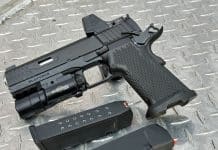I recently discussed the Soviet-designed (and now Russian-built) S-300 surface-to-air missile (SAM) system, which has been sold to a number of nations including Syria, India, and China. The S-300, however, is far from the latest Russian technology—that distinction belongs to the S-400 Triumf (NATO designation SA-21 Growler).
The S-400 is based extensively on the S-300—in particular the late-generation S-300PMU, although it represents a significant advance in capabilities. Upgrades were focused in two main areas: the missiles and the radar and tracking software.
The new radars include the 92N2E Grave Stone with frequency hopping capabilities, the 96L6 acquisition radar, and the 91N6E phased array acquisition radar. These radars are notable for their ability to provide mid-course corrections for missiles in flight, which—in combination with upgraded software—enables the S-400 to engage ballistic missiles.
The S-400 also employs four new missiles. The 48N6E3 is an upgraded version of the -E2 used with the S-300, with a range of 130 nautical miles. The 40N6 has an even longer range, at 215 to 240 nautical miles, and is specifically designed to kill aircraft supporting an attack or suppression of enemy air defenses (SEAD) mission such as the JSTARS, AWACS, or Navy EA-6B and EA-18G aircraft.
The Russians also added a short-range capability to the S-400 with the 9M96E (21.6 nautical mile range) and 9M96E2 (64.8 nautical mile range) missiles. Since they are much smaller than the primary interceptors, four can be fitted in one of the standard missile canisters on the S-400. Both are highly maneuverable, with designs similar to the AA-11 Archer air-to-air missile.
The S-400 had a long and difficult development, with initial tests of the system made in early 1999. The first deployment announcement was made in 2001, but problems plagued the program and deployment was pushed back to 2003 and then 2004, though the system was announced to have successfully destroyed a ballistic missile in April 2004. Further problems related to the use of older missiles for testing the system delayed deployment still further to 2005 or 2006. Ultimately it was not until late summer 2007 that the first battalion of S-400s was deployed around Moscow.
The Russians claim that the S-400 has twice the range of the U.S. Patriot PAC-3 and that it is capable of intercepting ballistic and cruise missiles and stealth aircraft. However, such claims often contain more than their share of bluster, so in the absence of combat experience, it’s difficult to say exactly how capable the new system is. However, there is no doubt that it deserves to be treated with respect by U.S. pilots should they encounter it anywhere in the world.












